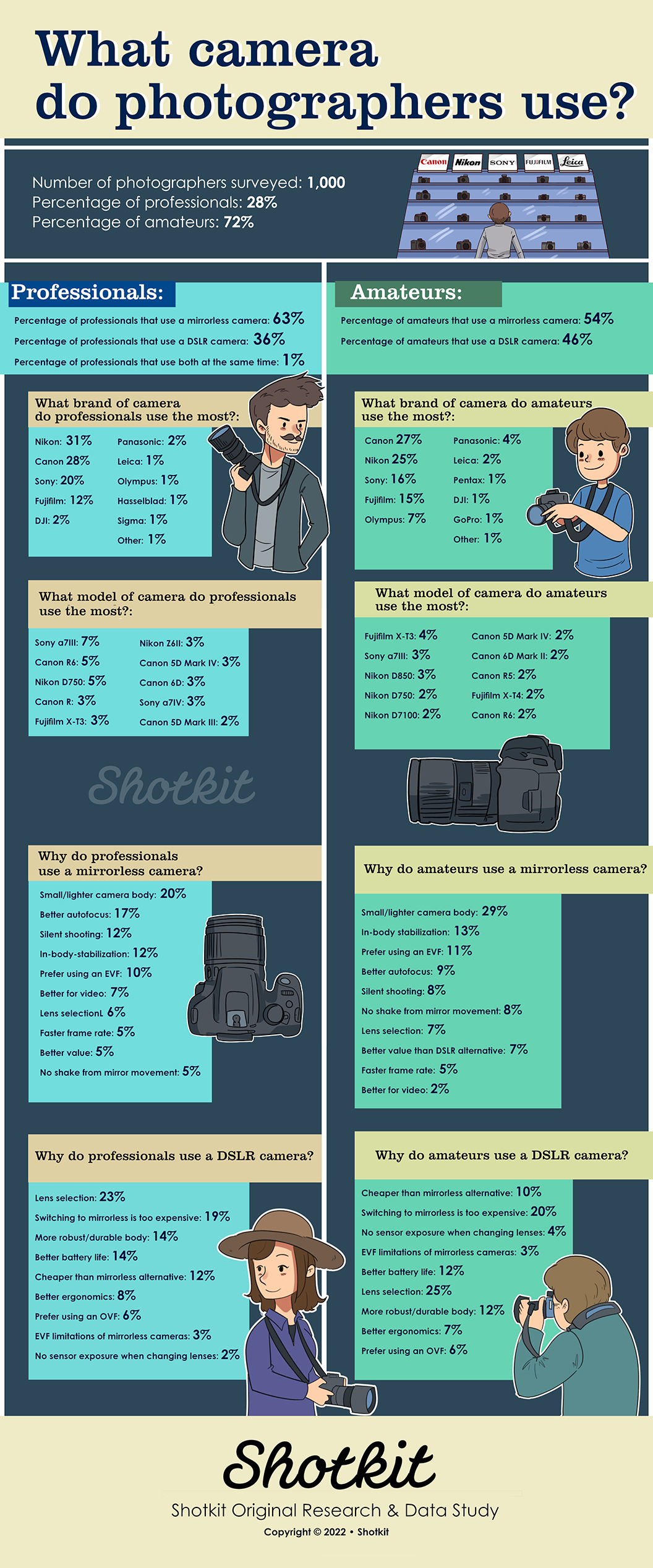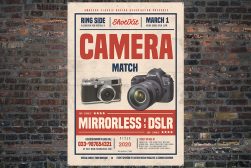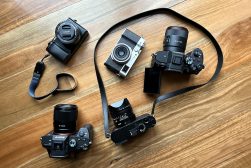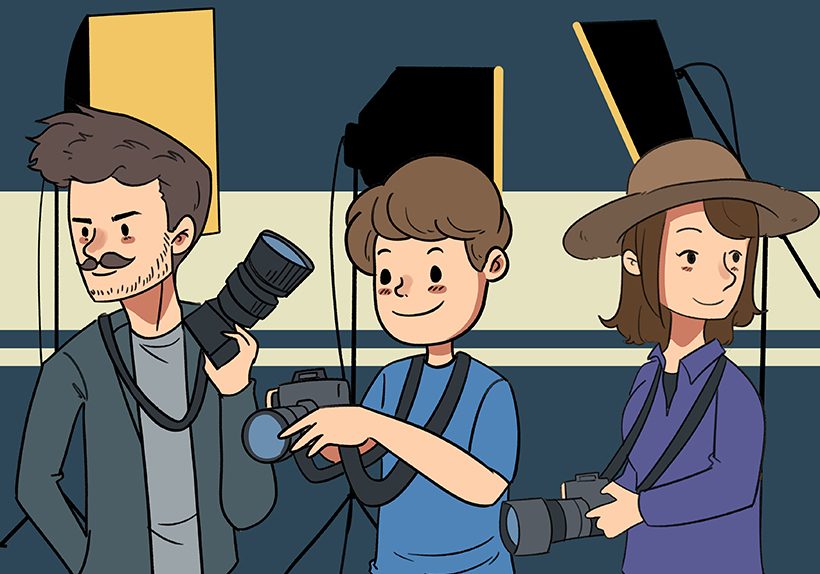
We Asked 1,000 Photographers What Camera They Use in 2024 (And the Results Surprised Us!)
Surprising results of a survey we conducted to discover what cameras professional and amateur photographers are using in 2024 and why.
Learn | By Mark Condon | Last Updated: February 6, 2024
We recently surveyed 1,000 photographers to answer the question:
What camera do amateur and professional photographers use in 2024?
We also looked at whether photographers are using DSLRs or mirrorless cameras and the reasons for their choice.
What we uncovered surprised us, and today I’m going to share our findings with you.
1. Mirrorless cameras are more popular than DSLR cameras for professional photographers. 63% of professional photographers use a mirrorless camera, while 36% of them use a DSLR camera. Only 1% use both.
2. Mirrorless cameras are more popular than DSLR cameras for amateur photographers too (but not by much). 54% of amateur photographers use a mirrorless camera, while 46% of them use a DSLR camera.
3. The most common reason why professional photographers use mirrorless cameras is that they are smaller and lighter. The second most common reason was that they offer better autofocus.
4. The most common reason why amateur photographers use mirrorless cameras is that they are smaller and lighter. The second most common reason was that they offer in-body stabilization.
5. Nikon is the most popular camera brand used by professional photographers. 31% of professionals use Nikon, closely followed by Canon (28%) and Sony (20%).
6. Canon is the most popular camera brand used by amateur photographers. 27% of amateurs use Canon, closely followed by Nikon (25%) and Sony (16%).
7. The Sony a7III is the most popular camera used by professional photographers. 7% of pros use the Sony a7III mirrorless camera, with the Canon R6 mirrorless camera and Nikon D750 DSLR camera coming in joint 2nd and 3rd.
8. The Alpha a7III and the Nikon D850 are the most popular cameras used by amateur photographers. One is a mirrorless camera and the other is a DSLR.
9. Professional photographers like to use the Sony a7III for their personal photography pursuits too. The Fujifilm X-T3 and Nikon D850 are also popular choices.
10. The most common reason why both amateur and professional photographers use DSLR cameras is due to the superior lens selection. The second most common reason was that switching to the mirrorless system is too expensive.
Share this Image On Your Site by Copying the HTML Content Below:
Mirrorless Cameras are More Popular than DSLRs for Both Professional & Amateur Photographers
We found that approximately 63% of professionals use a mirrorless camera and 36% use a DSLR. Only 1% use a combination of both:
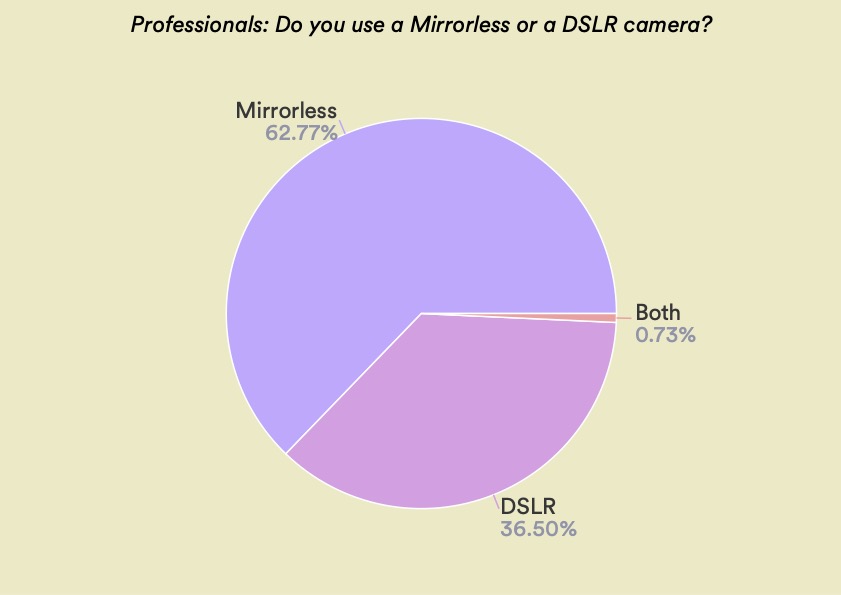
As for amateur photographers, approximately 54% use a mirrorless camera and ~46% use a DSLR:
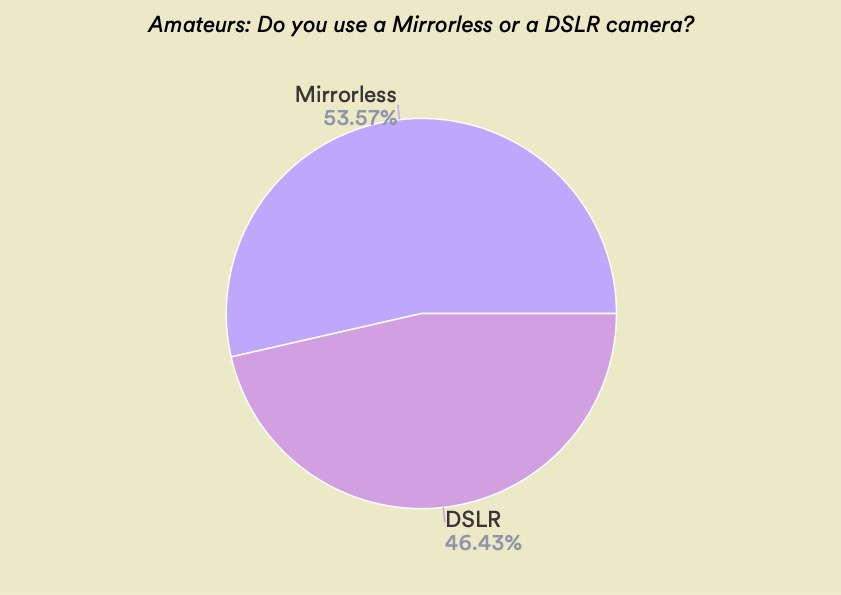
This confirmed our expectations, with the mirrorless format being more popular than DSLRs in 2024.
However, the use of DSLRs is still common among both amateur and professional photographers.
(See also: What is the best camera for professional photography?)
Nikon is the Most Popular Brand of Camera for Professional Photographers
Out of all the major camera brands, Nikon is the most popular among professionals with approximately 31% of respondents shooting predominantly with a Nikon camera.
The second most popular brand was Canon at 29%, followed by Sony (~20%) and Fujifilm (~12%) – see the differences between Sony and Fujifilm.
After this, the usage among professionals of other camera brands dropped significantly:
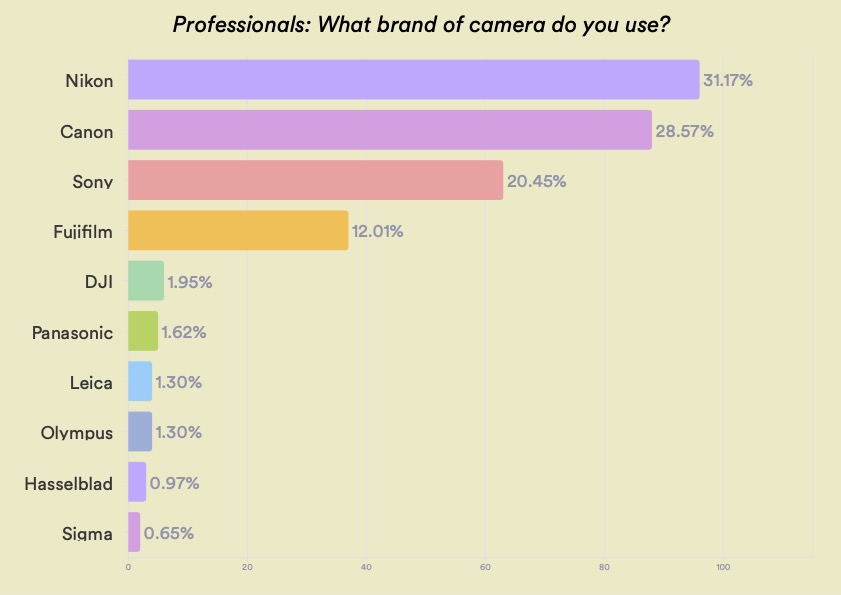
DJI was presumably higher than other camera brands since professional photographers use drones in conjunction with their cameras.
Leica and Hasselblad produce cameras that are much more expensive than other camera brands, so it was no surprise to see them lower in the rankings.
Sigma, with its limited offering of niche cameras, was also expected to be low in ownership among professionals.
We were expecting Canon to be the most commonly used brand by professional photographers above Nikon although the difference is not significant enough to draw conclusions.
As for the top 3 spots, Nikon, Canon, and Sony all produce full-frame cameras, the choice of pros.
Fujifilm, however, only produces APS-C format and medium-format cameras.
Panasonic and Olympus favour the micro-four-thirds sensor, which, while offering some advantages, is a far less popular choice for professionals due to the limitations of the sensor size (notably, poorer high ISO performance when compared to a larger sensor).
One can assume that the dominance of Nikon, Canon, and Sony among professionals is due to the selection of full-frame cameras, undoubtedly the most common camera sensor format in use by pros.
Canon is the Most Popular Brand of Camera for Amateur Photographers
Among amateur photographer respondents, Canon was the most popular camera brand (27.5%).
How Much Do You REALLY Know About Photography?! 🤔
Test your photography knowledge with this quick quiz!
See how much you really know about photography...

Nikon (~26%) was a close second, followed by Sony and Fujifilm:
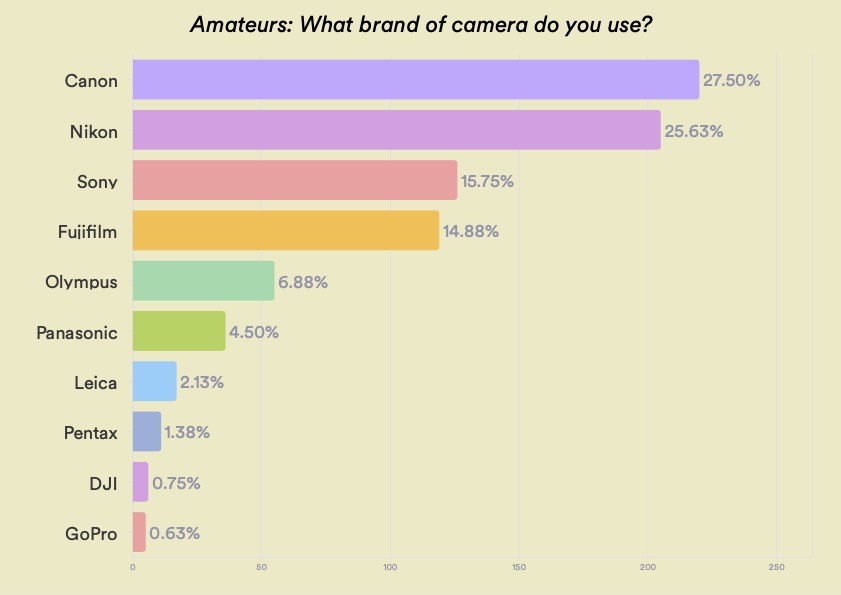
Again, the difference between the top 2 spots was not significant enough to draw any major conclusion.
The same can be said for the 3rd and 4th spots, with the popularity of Sony and Fujifilm below Canon and Nikon being the expected outcome.
The percentage of respondents who own a Leica camera (2%) was an interesting outcome.
This shows that a small percentage of photographers that don’t earn an income via their photography are still inclined to invest in expensive camera brands.
Micro-four-sensor cameras and lenses are less expensive than other (larger) formats of sensor, which may explain the greater proportion of Olympus (~7%) and Panasonic (~4.5%) users among amateur photographers than professionals.
Also, the need for better high-ISO performance (offered by a bigger sensor) is arguably less essential among non-pros.
The Sony a7 III is the Most Popular Camera for Professionals
Among professional photographers, the Sony Alpha a7 III full-frame mirrorless camera is most commonly used (~7%).
The Canon EOS R6 full-frame mirrorless camera is the second most commonly used (~5%):
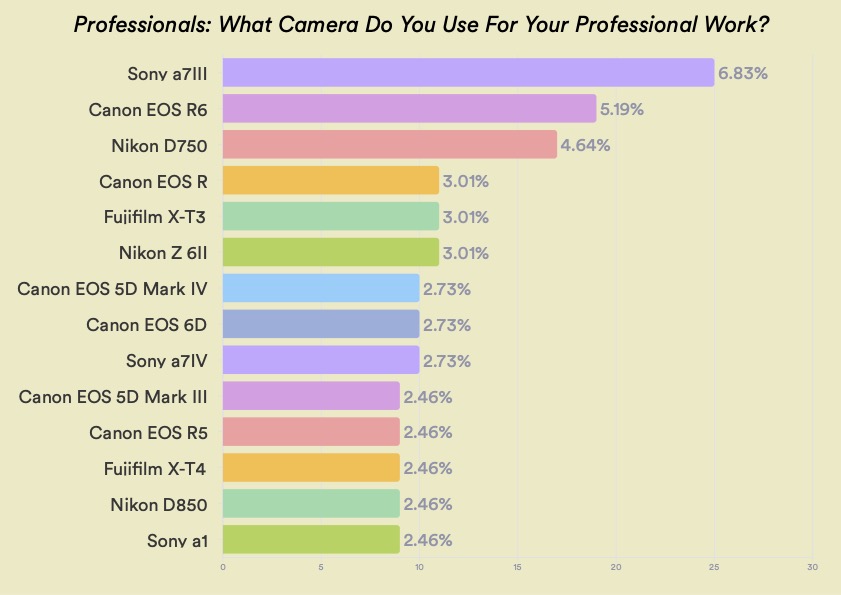
(Limited to top 15 responses.)
Despite being over 4 years old, the Sony a7 III is still enormously popular among professional photographers.
Interestingly, its successor (the Sony a7 IV, which was released in December 2021) appears much further down the list (~3%).
Last year, the Sony a7 III was our pick as the best mirrorless camera. (This year, we chose the Sony a7 IV.)
Anecdotally, I know several professional photographers who see no need to upgrade from the (already excellent) Sony a7 III to the newer model.
(I shoot professionally with both the a7 III and a7 IV and can appreciate the advantages of both models.)
The Canon EOS R6 is another hugely popular camera, especially among wedding photographers.
It’s surprising to see the Nikon D750 full-frame DSLR in 3rd place, with approximately 5% of respondents still using this 8-year-old camera.
Widely touted as one of the best DSLR cameras ever produced, the D750 was especially popular among wedding photographers due to its impressive high-ISO performance and articulating screen (rare at the time for a full-frame camera).
In 4th place, the APS-C sensor Fujifilm X-T3 (released in September 2018) is another camera that was placed above its successor, the Fujifilm X-T4.
Fujifilm cameras have a cult-like following due largely to their film-camera aesthetics, film-simulation presets, and excellent image quality.
Fujifilm lenses are more affordable than full-frame equivalents, which may be another reason for the popularity of the X-Series cameras.
The Sony a7 III is the Most Popular Camera for Professionals for Personal Photography
This was a part of the survey conducted for my own personal interest.
As a professional photographer who owns several cameras, I prefer to use different cameras for my personal photography (mostly pictures of family members) vs any paid (professional) work.
I wanted to see if the same was true for other professionals:

(Limited to top 15 responses.)
When comparing the two sets of results, it’s clear that many professionals also prefer to separate their ‘personal’ camera from their ‘work’ camera.
However, the Sony a7 III is still the most popular camera (~4%), which indicates that perhaps professionals are using the same camera for both paid and personal photography.
A ‘non-work’ camera is something that can be less functional but is perhaps more pleasurable to use, be that in its simplicity, some aesthetic value or the even just the diminished size/weight of the camera body.
Some professionals may also prefer for their ‘personal-use’ camera to be more challenging to use than their ‘work camera ‘- an analogue (film) camera, for example.
(Incidentally, there were no film cameras in use by professionals who responded to the survey.)
The cameras used by professional photographers for their personal photography ranged from full-frame and APS-C sensor mirrorless cameras (Sony a7 III, Fujifilm X-T3) to full-frame and APS-C sensor DSLRs (Nikon D850, Nikon D7100).
The 8-year-old APS-C sensor Sony a6000 mirrorless camera also made a surprise appearance.
The Fujifilm X-T3 is the Most Popular Camera for Amateurs
Released back in September 2018, the APS-C sensor Fujifilm X-T3 mirrorless camera is most popular among amateur photographers (~4% of respondents).
In second place (~3%), the full-frame Sony a7 III mirrorless camera appears again.
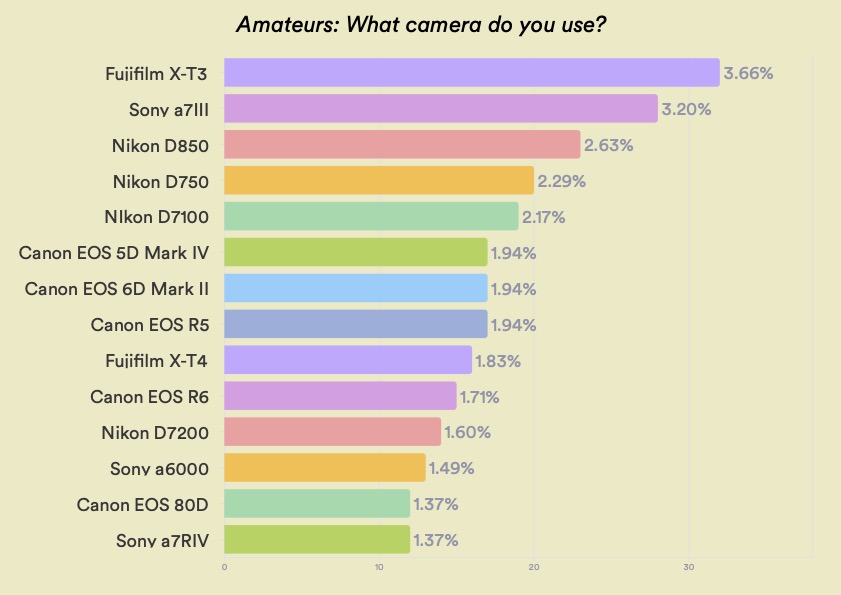
(Limited to top 15 responses.)
At over US$2,700 and built for the rigours of professional photography, the Nikon D850 full-frame DSLR was a surprise at position 3 (~3%).
Interestingly, the 8-year-old Nikon D750 appears in 4th place, belying its age.
In 5th place, the APS-C sensor Nikon D7100 DSLR camera shows relatively strong popularity too.
Overall, it’s impressive that an APS-C sensor camera is placed above all the other full-frame models, giving an indication of the strength of the Fujifilm X-trans sensor.
Professionals use Mirrorless Cameras Because They Are Smaller & Lighter (Than DSLRs)
Despite the fact that some modern full-frame mirrorless cameras are actually similar in size and weight to DSLRs, approximately 20% of pros still choose mirrorless bodies based on their smaller dimensions and weight.
The next most common reason (~17%) for professional photographers using mirrorless cameras is that they have better autofocus performance than DSLRs:

Silent shooting (~12%) is important for professionals to remain discrete – for example, wedding photographers who need a silent camera during ceremonies.
In-body stabilization will always be much better in a mirrorless camera body than in a DSLR, so this was another common response (~12%) in our survey.
Around 10% of pro photographers prefer using an EVF over an OVF, presumably due to the instant feedback of any exposure adjustments.
Mirrorless cameras are also better for shooting video, (although certain DSLR models are no slouch in this regard), so seeing this response (~7%) was no surprise.
The availability of certain mirrorless-only lenses came in at ~7%, which was an interesting one, since there are far fewer mirrorless-specific camera lenses than those made for DSLRs.
However, certain lenses are only available for mirrorless camera bodies (e.g. Canon RF 24-70mm f/2). In addition, you can easily adapt lenses for use on mirrorless camera bodies.
Overall, these responses support the fact that the Sony a7 III is the most popular mirrorless camera among professional photographers. While other models also excel, the a7 III is known for its compact dimensions, excellent autofocus and in-body stabilization.
Amateurs use Mirrorless Cameras Because They Are Smaller & Lighter (Than DSLRs)
Amateur photographers also seem to favour mirrorless cameras over DSLRs due to their smaller dimensions and weight (~29%).
This was by far the most common response, which shows the importance of owning a compact camera:
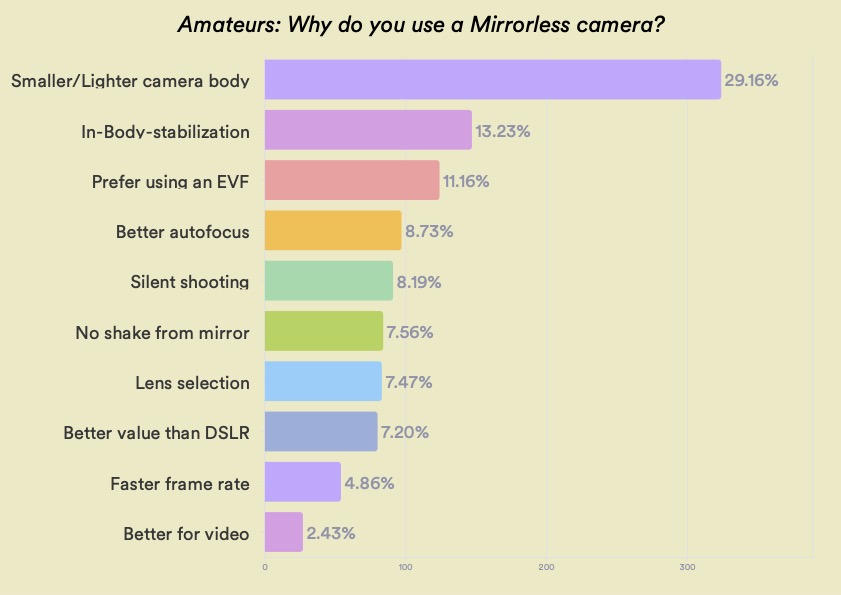
Amateurs also prefer using a camera with superior in-body-stabilization (13%), which gives some indication of usage – IBIS is helpful for low-light shooting, using longer lenses and video capture.
The presence of an EVF on mirrorless cameras, as opposed to an OVF on a DSLR, was the 3rd most common reason (~11%).
EVFs definitely make the photo-taking process easier, while providing real-time information that OVFs cannot.
Professionals use DSLRs Because of the Lens Selection
The 36% of professionals who use a DSLR camera do so because of the superior lens selection (~23%).
There are many more Canon and Nikon lenses made for DSLR camera bodies than for mirrorless camera bodies, for example.
The second most common reason for using DSLRs was one of expense – changing systems is expensive, especially when the photographer is invested heavily into lenses and accessories.
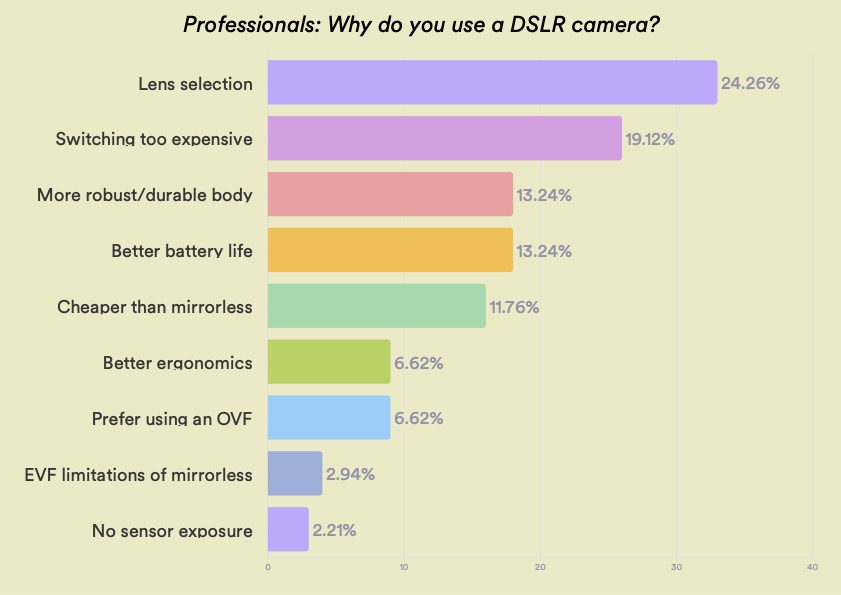
Unsurprisingly, the fact that DSLR camera bodies are more robust and durable than their mirrorless counterparts came in at reason number 3 (~14%).
Flagship DSLR camera bodies such as the Nikon D6 or Canon 1DX Mark III are known for their indestructibility and longevity of shutter life.
‘Better battery life’ was also no surprise (~14%) as one of the key reasons for choosing a DSLR, although the batteries in the latest mirrorless cameras can survive much longer than earlier models.
DSLRs are also on the whole cheaper than mirrorless cameras, although based on the different technology and features involved it isn’t an apples-to-apples comparison.
It’s also worth noting that there are many more affordable lenses available for DSLR cameras than there are for mirrorless cameras – the classic ‘nifty-fifty’ Nikon/Canon 50mm f/1.8, for example.
The ergonimics of mirrorless cameras are undeniably worse than those of a DSLR (largely due to most brands’ insistence to keep producing smaller bodies), but there’s been an improvement with recent releases (notably the Canon R-series, Nikon Z-series and Sony a7 IV, with its deeper grip).
Amateurs use DSLRs Because of the Lens Selection
Approximately 25% of amateur photographers who own a DSLR, do so because of the superior lens selection when compared to the current mirrorless camera offering.
There are many more Nikon and Canon lenses made for DSLR camera bodies than there are for mirrorless camera bodies, for example.
Also, switching from DSLR to mirrorless is an expense that ~20% of amateurs would prefer not to pay.
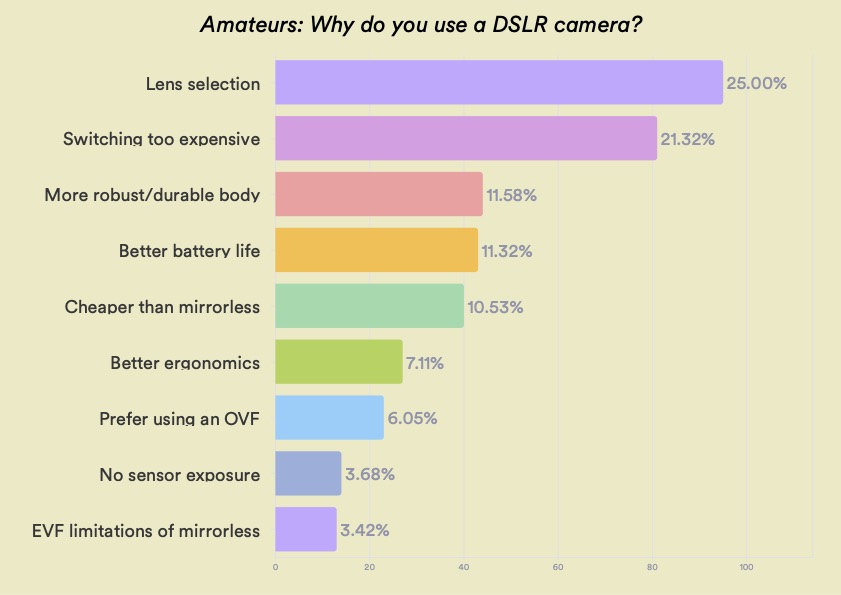
Battery life and robustness of the DSLR camera body came in at joint 3rd spot (~12%), with the expense of mirrorless cameras in 5th position (~10%)
Interestingly, approximately 6% of amateur photographers actually prefer using an OVF to an EVF.
Reasons for this may include the ‘realness’ factor of using an OVF, the fact that an EVF can be difficult to adjust to for people with glasses, or simply that the joy of ‘pure’ photography can feel diminished by what is essentially a tiny computer screen.
It’s also interesting to note that some amateur photographers (~4%) value the fact that the mirror in a DSLR helps to prevent needless sensor exposure.
(Some mirrorless cameras such as the Canon R and Sony a7 IV have actually solved this issue with an automatic sensor cover, although this is not a commonly touted key feature.)
Final Notes on How the Survey was Conducted
After creating the survey using JotForm, we shared the link in various places:
- Facebook Groups
- Shotkit email subscribers
- Shotkit Facebook followers
We took care to select ‘neutral’ photographer groups that wouldn’t skew the results with specific brand loyalty, etc.
i.e. we didn’t share a link to the survey in the Fuji X-Photography Facebook Group!

Obviously, there are various limitations and assumptions when conducting a survey of this type on a relatively small scale.
Next time, for example, we will collect data from a larger number of photographers and devise a way to display more responses in a concise format.
We will also go more in-depth regarding the various reasons photographers choose one camera over the other.
If you have any suggestions which may help improve future surveys, please leave them in the comments section below.
You should also check out our article on camera industry stats and the results of our survey on what photo editing software photographers use.

Check out these 8 essential tools to help you succeed as a professional photographer.
Includes limited-time discounts.





